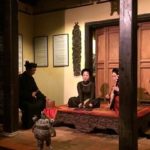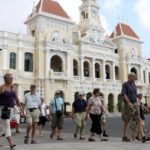The Loyalty Oath Festival of Dong Co Temple in Tay Ho District, Hanoi has been listed by the Ministry of Culture, Sports and Tourism as a national intangible cultural heritage due to its historical and cultural values.
The Dong Co Temple Loyalty Oath Festival has been held in the capital for nearly 1,000 years.
The Festival of the Mandarins is a special occasion in which both officials of ancient times and current party members take an oath of loyalty to their country. It is also a time for people to give thanks to their ancestors and to pray for peace and prosperity for their nation.
| A traditional ritual during the Loyalty Oath Festival of Dong Co Temple. Photo: VNA |
In 1028, Dong Co Temple was built at the confluence of the Thien Phu and To Lich rivers in Dong Xa Village, which is now located at 353 Thuy Khue Street, Tay Ho District, Hanoi.
King Ly Thai Tong decreed that the Festival of Loyalty Oath be held annually at Dong Co Temple. All court dignitaries were required to solemnly swear their allegiance to the king and the nation. This year, the festival will take place on May 22, which is the fourth day of the fourth lunar month.
Although 995 years have passed, the cultural identity of the Dong Co Temple festival has remained intact.
According to Do Dinh Hong, Director of Hanoi’s Department of Culture and Sports, the Dong Co Temple Festival was the court’s festival.
The national festival for allegiance-swearing had a special significance, so King and court took great care to attend it. Most court dignitaries and the people of Thang Long Citadel came together with a spirit of loyalty and filial piety, praying for the nation’s peace and prosperity. In the Tran Dynasty, the festival was a celebration of the court officials’ integrity, according to Hong.
Apart from the Loyalty Oath Festival of Dong Co Temple, the Ministry of Culture, Sports and Tourism has listed 11 other cultural relics on the National Intangible Cultural Heritage List, including folk performing arts, traditional festivals and traditional crafts.
| The fire dance ceremony of Pa Then people has been recognized as a national intangible cultural heritage. Photo: VNA |
Among the newly recognized heritages, there are four in the northwestern province of Tuyen Quang: “Fire Dance Ceremony of Pa Then People”; “Hong Thai Communal House Festival”; “Tay People’s Knowledge of Water”; and “Tay People’s Knowledge and Practices of Wet Rice Cultivation”.
The northwestern province of Dien Bien has four new additions to its list of cultural heritages: “Dance Art of the Lao People”; “White Hmong Family Lineage Festival”; “Costume Art of the Ha Nhi People”; and “Blacksmithing of the Mong People”.
The other three are “Tay Lullaby”; “Tay Brocade Weaving”; and “Mong Khen Art”.
Ancient house in Ma May
NDO – Ma May, a rare quarter that still retains several old houses, has created one of the characteristics of Hanoi. Hanoi’s streets are becoming increasingly crowded and traditional features can sometimes be hidden behind modern life. But if one takes the time to relax and look around, the ancient features begin to reveal themselves.
Hanoi, HCM City see good growth of tourism revenue
NDO – In the first ten months of 2016, the revenue of Ho Chi Minh City’s tourism industry amounted to VND80 trillion while Hanoi’s reached over VND50 trillion.










